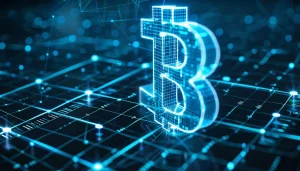Curious About 2025’s Top Blockchain dApps? Here’s What You Must Know!

Table of Contents
We live in an ever-evolving era where frequent advancements are part and parcel of life. This also applies to blockchain technology.
Bitcoin debuted in 2009, and since then, we have only seen it grow. Just a year after its inception, excitement was buzzing. While the hype has gone through ups and downs, innovation has never taken a back seat.
As of last year, there were 560 million cryptocurrency users worldwide.
Even today, blockchain is still evolving and holds potential for the future, with new developments on the horizon.
So, let’s take a look at what’s in store for 2025.
Top Blockchain dApps Trends You Must Know About

Without further ado, let’s unpack more.
MFEV
MFEV is something to keep an eye out for in 2025. With its emphasis on scalability, security, and energy efficiency, MFEV addresses critical challenges faced by decentralized applications (dApps).
As more people use blockchain, MFEV’s fast and cost-effective solutions meet the need for secure and sustainable platforms.
With the rise of smart contracts and tools for developers, MFEV has become even more valuable.
MFEV strives to offer an intuitive environment for building and deploying dApps. This aligns with the growing need for efficient, scalable, and secure blockchain solutions in 2025.
Why MFEV is the Future for dApp Development?
As aforementioned, MFEV is the perfect blockchain for building dApps because it’s fast, secure, and highly scalable.
Since it’s EVM-compatible, developers can easily create and launch dApps without any hassle.
Also, MFEV’s advanced security features keep transactions safe. Hence, it’s a reliable choice for users. It even focuses on energy efficiency.
Whether it’s DeFi, gaming, or real-world asset tokenization, MFEV provides the ideal foundation for innovative blockchain applications. As the demand for decentralized solutions grows, MFEV is ready to support the next generation of dApps with speed, security, and seamless integration.
Trending dApp Categories That Can Be Built on MFEV!
Here are the trending dApp categories that can be built on MFEV!
- MFEV’s EVM compatibility lets developers build and deploy DeFi applications such as decentralized exchanges.
- MFEV supports staking mechanisms that let users participate in network security while earning rewards.
- Secure crypto wallets and payment gateways can be built on MFEV to facilitate seamless transactions.
- MFEV’s scalability and low transaction costs make it ideal for NFT marketplaces, blockchain-based games, and metaverse applications.
- As an EVM-compatible blockchain, MFEV enables easy deployment of Ethereum-based smart contracts. This enables businesses to automate agreements, enforce digital contracts, and build trustless applications.
- MFEV enables the tokenization of real-world assets such as real estate, commodities, and fine art. This makes way for fractional ownership and easier trading while ensuring security and transparency through blockchain technology.
- Businesses can leverage MFEV to develop custom blockchain applications for secure data sharing, supply chain management, identity verification, and document authentication.
Ethereum 2.0
Ethereum 2.0 is a major update to the Ethereum blockchain. It is said to improve scalability and energy efficiency.
With the transition to a proof-of-stake (PoS) system, Ethereum 2.0 reduces the energy consumption of transactions compared to its previous proof-of-work model.
This helps Ethereum process more transactions at a faster rate. So, it can be more efficient for decentralized applications (dApps).
Polkadot
Polkadot is a blockchain platform designed to connect different blockchains to ensure all of them work together.
It uses a system called parachains, where multiple specialized blockchains can run in parallel while also sharing security and resources. This approach solves scalability problems as many transactions can be processed at once.
Avalanche
Avalanche is a blockchain platform known for its high-speed performance and efficiency. It can process up to 4,500 transactions per second.
It is designed to be scalable and to ensure it can handle a large number of users and transactions without slowing down. It also operates with low latency, ensuring quick transaction confirmations.
Chainlink
Chainlink is becoming important in 2025 as a decentralized Oracle network. It connects smart contracts on blockchains to real-world data, such as price feeds or weather information, which is crucial for many decentralized applications (dApps).
Without reliable data from outside the blockchain, smart contracts can’t function properly. So, Chainlink solves this problem by securely bringing real-world data to the blockchain.
Its technology is widely used in decentralized finance (DeFi), where accurate data is essential for things like lending, trading, and insurance.
SUI
SUI is a blockchain platform gaining attention in 2025. This is because of its advanced features. It stands out with a scalable framework that can handle many transactions at once, thanks to parallel processing.
This makes it faster and more efficient. SUI also uses an innovative programming language called ‘Move,’ which is designed to make developing smart contracts easier and safer.
How Blockchain is Shaping the Future: Regulations, Tokenization, and Industry Transformation
Blockchain technology continues to evolve and shape industries, financial systems, and more. In 2025, key developments such as clearer regulations, real-world asset tokenization, and deeper industry integration are paving the way for mass adoption. Here’s a closer look at these transformative trends.
Regulatory Developments
In 2025, several countries are shifting their focus on improving cryptocurrency regulations.
Europe has introduced the MiCA regulation to address challenges like volatility and cybersecurity in the digital asset market. It ensures security and transparency so companies can operate without fear of unclear rules while protecting investors.
In the U.S., the SEC plans to update its crypto policies under new leadership. They will clarify when cryptocurrencies are considered securities and review ongoing cases. This is done to support the growth of the digital asset industry with clearer rules.
India is also working on comprehensive crypto regulations, which are expected by mid-2025. The government wants to balance innovation with safety and create a secure environment for blockchain and cryptocurrency adoption while following global standards.
Tokenization of Real-World Assets
Tokenization is when you turn real-world assets like real estate, art, or commodities into digital tokens on a blockchain. This trend is growing in 2025 because it lets people buy shares in expensive assets, like properties, without needing to invest the full amount.
For example, Dubai’s DAMAC Group partnered with the blockchain platform MANTRA to tokenize $1 billion worth of assets.
This enables fractional ownership where people can own smaller portions of these assets.
Integration with Traditional Industries
Blockchain is being integrated into traditional industries. This is done to make the systems more efficient and transparent.
In India, for example, the Odisha provincial government is using blockchain technology to improve the support systems for survivors of gender-based violence.
This use of blockchain helps store sensitive data securely and makes sure that information cannot be tampered with.
Transformation In The Financial Sector
Blockchain is transforming the financial sector by enabling decentralized financial services (DeFi).
With DeFi, traditional banks and intermediaries are no longer necessary for things like lending, borrowing, and trading. This reduces transaction costs and the financial services become more affordable.
Blockchain also enables faster transactions and greater access to financial services. So, it can be a boon for people without access to traditional banking. Today, we see more platforms and applications adopt DeFi. So, the financial systems are becoming more inclusive, transparent, and efficient.
Wrapping Up
2025 looks like a great year for blockchain dApps. Exciting developments are happening in many areas.
Blockchain is improving transparency, security, and efficiency, changing everything from government systems to global finance.
As regulations become clearer and dApps become easier to use, it is attracting more developers, investors, and users to join.
With ongoing technology improvements and better regulations, blockchain dApps are set to play a key role in shaping the digital future.
MFEV is also leading the charge in 2025 with its scalable and secure blockchain solutions. To know more, visit mfev.io!



